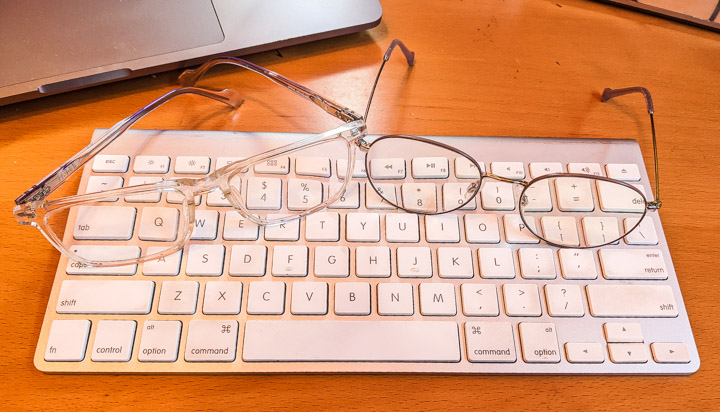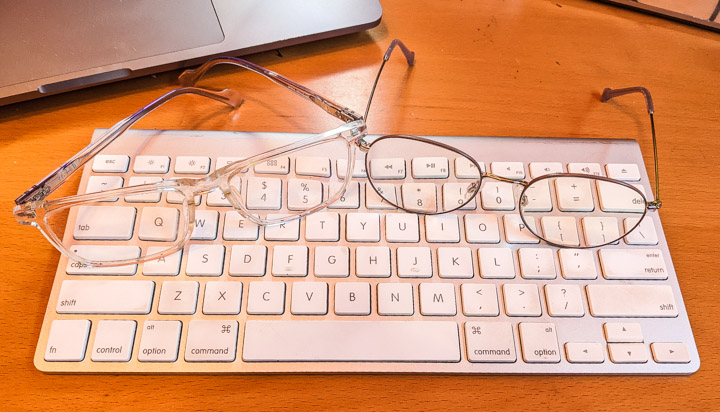
Let me guess: You spend a lot of time in front of a computer, to which is attached a large high-resolution outboard screen, and you’re over 40, and you have glasses on your face. A lot of you will already know this, but if you don’t, run not walk to the nearest optometrist, get your eyes checked, and order a set of “computer glasses”. Trust me on this.
If you’re wearing “reading glasses” · You should go get an eye checkup anyhow, so you can get computer glasses, but also because an eye checkup can find out all sorts of problems that might become serious if untreated, like glaucoma and macular degeneration. Also, they’re pretty cheap, most places.
My eyes are decent for someone past sixty: Galloping presbyopia (“age-related farsightedness”) which has gradually extended far enough that my prescription is for progressive lenses with a mild long-distance boost.
Smaller yet bigger · To illustrate the problem, check out the picture above: My ordinary everyday glasses on the left, computer glasses on the right. When I first looked at the picture after taking it I was shocked, because I’d been convinced that the computer glasses were much the bigger of the two, which they’re not. I was fooled because the proportion of my everyday glasses that works at screen distance is pretty small, and located way down in the lower half of the lens. On the computer glasses, the proportion is 100%.
Which means that on my big 4K outboard screen, when I want to glance at the top right corner to check out the time of day, I had to bend my neck way back to get the glasses in the right place so I could read the numbers. When I was working on a blog piece in one window and editing a photo in another I was forever swiveling around to aim the glasses’ tiny sweet spot. A big IDE window with panes for code, project files, debug output, and so on was a problem too. I kept increasing font sizes, but that’s really not a good solution.
With the computer specs, things are just dramatically better, and I’ve turned the fonts back down, and I just do everything faster, and I know what time it is at a glance.
Now, for a laptop down on my lap, the everyday glasses work just fine, which is a good thing because I probably want to switch attention between that and the ball game or costume drama on the big screen across the room.
How to do it · First, grab a tape measure, then sit down and and measure the distance between your eyes and the screen. Then, go to the optometrist and get that examination, then go to a good glasses merchant and show them your prescription and tell them the measurement and say you want computer glasses.
Um, I don’t pretend to be a fashion consultant, but do bear in mind that these glasses are going to feature prominently in all those videoconferences.
I’ll be honest, this is my biggest quality-of-life improvement in several years.
By .
The opinions expressed here
are my own, and no other party
necessarily agrees with them.
A full disclosure of my
professional interests is
on the author page.
如有侵权请联系:admin#unsafe.sh
